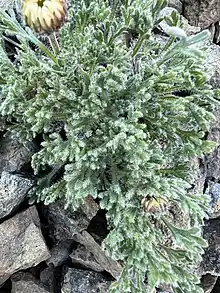Erigeron compositus
Erigeron compositus is an Arctic and alpine species of fleabane in the family Asteraceae.[3] Common names include dwarf mountain fleabane, cutleaf daisy, and trifid mountain fleabane.[4][5]
| Erigeron compositus | |
|---|---|
.jpg.webp) | |
 | |
| Leaves | |
| Scientific classification | |
| Kingdom: | Plantae |
| Clade: | Tracheophytes |
| Clade: | Angiosperms |
| Clade: | Eudicots |
| Clade: | Asterids |
| Order: | Asterales |
| Family: | Asteraceae |
| Genus: | Erigeron |
| Species: | E. compositus |
| Binomial name | |
| Erigeron compositus Pursh | |
| Synonyms[1] | |
| |
Range
Erigeron compositus has been found in the Russian Far East (Wrangel Island and Chukotka), Alaska, Greenland, much of Canada (all three Arctic territories plus British Columbia, all three Prairie Provinces, Quebec, Newfoundland, and Nova Scotia), and the Western United States (from the Pacific Coast as far east as the Dakotas, Colorado, and New Mexico).[3][6]
Description
Erigeron compositus is a perennial herb rarely more than 25 cm (10 in) tall, with a thick growth of basal leaves, the tips of which are divided.[7] The plant produces a taproot and spreads by means of horizontal underground rhizomes. The leaves are often densely hairy but can range to fully glabrous. There is generally only one flower head per stem, each head with 20–60 white, pink or blue ray florets; these are sometimes small and easily mistaken for disc florets. Genuine disc florets are yellow and in the center of the head. The flower stem and bract is covered with hairs, often glandular.[8]
Habitat
Erigeron compositus grows in rocky areas in mountains up to 3,000 meters in elevation.
References
- The Plant List, Erigeron compositus Pursh
- Tropicos, Erigeron compositus Pursh
- S.G. Aiken, M.J. Dallwitz, L.L. Consaul, C.L. McJannet, R.L. Boles, G.W. Argus, J.M. Gillett, P.J. Scott, R. Elven, M.C. LeBlanc, L.J. Gillespie, A.K. Brysting, H. Solstad, and J.G. Harris 2007. Flora of the Canadian Arctic Archipelago, Erigeron compositus Pursh
- "USDA Plants Database".
- Pan-arctic flora, 860701 Erigeron compositus Pursh
- Biota of North America Program 2014 state-level distribution map
- Taylor, Ronald J. (1994) [1992]. Sagebrush Country: A Wildflower Sanctuary (rev. ed.). Missoula, MT: Mountain Press Pub. Co. p. 140. ISBN 0-87842-280-3. OCLC 25708726.
- Flora of North America, Erigeron compositus Pursh, Fl. Amer. September 2: 535. 1813. Dwarf mountain fleabane, vergerette à feuilles segmentées
